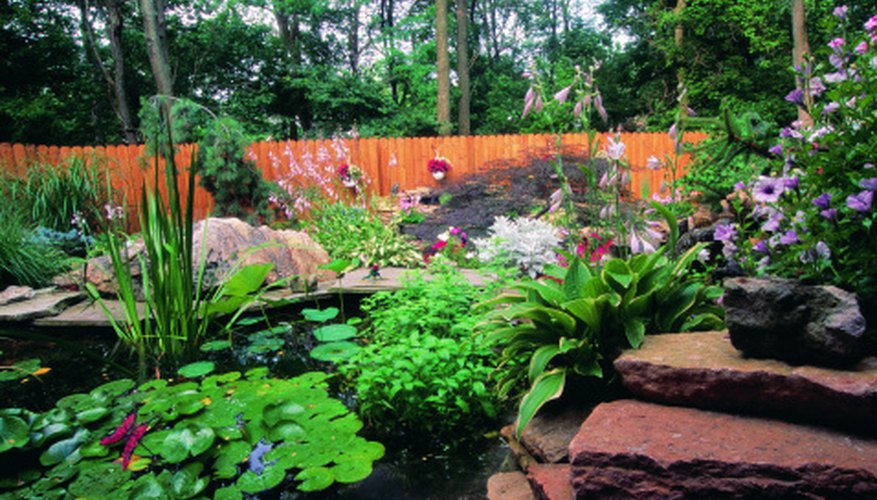Installing your own two-level pond gives you the freedom to select the location, the size and the shape of your pond. As you plan your pond installation, decide whether you want to use your pond as a focal point and plan the rest of your landscaping around it or work your two-level pond into the existing landscaping in your yard. Once you have made these important decisions regarding your pond you will be ready to break ground and get your hands dirty.
- Installing your own two-level pond gives you the freedom to select the location, the size and the shape of your pond.
- As you plan your pond installation, decide whether you want to use your pond as a focal point and plan the rest of your landscaping around it or work your two-level pond into the existing landscaping in your yard.
Select the location for your two-level pond. You will need an open space large enough to accommodate two ponds, your upper and lower levels. Do not place it in an area closely surrounded by trees because you will end up having to clear leaves out of your pond. A sloped area works best for a two-level pond because one level will need to be higher than the other.
Select two rigid, preformed pond liners. The lower level should be larger than the upper level. Place the liners on the ground in the desired location and trace the outline by sprinkling chalk dust on the ground. The outer edge of the upper level of your pond should be at least 6 inches from the outer edge of the lower level to allow space for a waterfall.
Dig out the pond areas. Check the depth of the holes as you dig and stop when the holes are 2 inches deeper than the height of the first shelf in the pond liner. Dig out the areas for the deeper section of the pond liner next, leaving the shelf areas intact. Dig to 2 inches below where the bottom of the pond liner will sit.
- Select two rigid, preformed pond liners.
- Check the depth of the holes as you dig and stop when the holes are 2 inches deeper than the height of the first shelf in the pond liner.
Fill the holes with 2 inches of damp sand and spread it evenly along the shelves and in the bottom sections of each hole. Check that the sand is level and compacted, then insert the pond liners into the holes.
Dig a channel between the upper and lower levels of the pond. Make the channel at least 6 inches wide and 6 inches deep. Cut a strip of plastic pond liner wide enough to overlap the sides of the channel by 4 or 5 inches and long enough that it can be draped over the rims of the pond liners. Lay the liner in the channel and drape the excess at both ends inside the rigid pond liners.
- Fill the holes with 2 inches of damp sand and spread it evenly along the shelves and in the bottom sections of each hole.
- Cut a strip of plastic pond liner wide enough to overlap the sides of the channel by 4 or 5 inches and long enough that it can be draped over the rims of the pond liners.
Disguise the edges of your ponds with flat river rocks. Create a border around the pond edges, fitting the rocks together like puzzle pieces. Use smaller river rocks to line the bottom and walls of the channel. Line the inside of the channel first then stack additional rocks along the border of the channel to cover the excess pond liner.
Install a pump filter in your pond. Consult with a professional at your local home and garden supply store to determine what size pump you need for your particular pond. Set up the pump end of the filter in the larger, lower level of the pond.
- Install a pump filter in your pond.
- Consult with a professional at your local home and garden supply store to determine what size pump you need for your particular pond.
Feed the filter's outlet hose up through the channel and into the upper level of the pond. If your pump filter does not come with a long enough outlet hose, purchase a hose from your local pond supply store. You may choose to rearrange the rocks lining the channel to disguise the hose.
Fill both levels of your pond with water. Fill the lower level of the pond completely but do not fill the upper level of the pond all the way.
Turn on your pump filter. The filter should pump the water from the lower level of the pond up through the hose and release it in the upper level where it will trickle down the channel and back into the lower level. Once your pump is running, add more water to the pond if desired.
TIP
Add landscaping to your pond by building a flowerbed around it. Turn the soil around your pond and mix in some fertiliser or compost and plant small shrubs and flowers. Select plants that will not grow so tall that they will obstruct your view of the pond.
